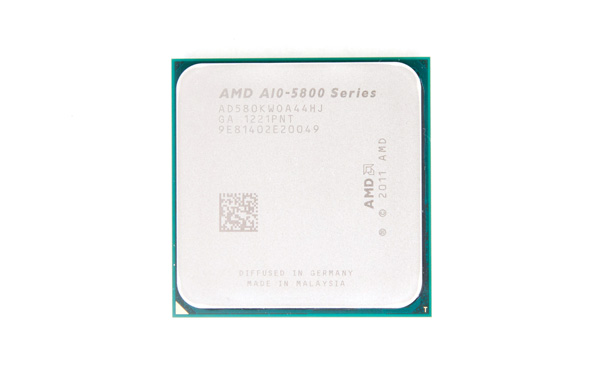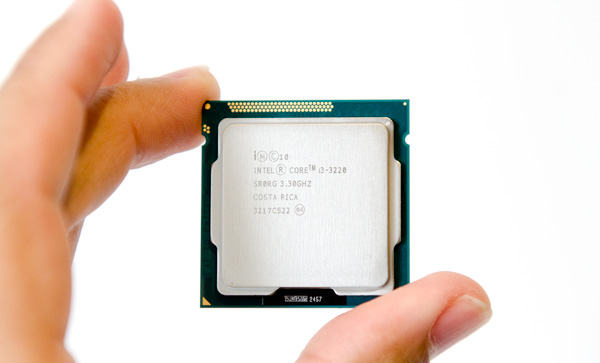AMD A10-5800K & A8-5600K Review: Trinity on the Desktop, Part 2
by Anand Lal Shimpi on October 2, 2012 1:45 AM ESTAlthough AMD's second-generation mainstream APU platform, codename Trinity, launched months ago in notebooks the official desktop launch is today. Rumor has it that AMD purposefully delayed the desktop Trinity launch to clear out unsold Llano inventories in the channel. Although selling APUs in notebooks is pretty easy, convincing desktop users to forgo the discrete GPU option (and ignore Intel) has been a tough battle for AMD. I keep going back to two slides that show us where AMD wants to go and the cores it'll take to get there:

The ultimate goal is this beautiful cohesive operation between CPU and GPU on a single die. That future will require a lot of software support, not only at the application level but also at the OS level. And I'm not talking about Windows 8. We're still far away from this APU dominated future, but AMD is marching in that direction. The second slide shows the x86 cores that we'll see from AMD along the way. AMD is still playing catch-up in the x86 CPU space and it's got a lot of lost time to make up for. There's no hiding the fact this is going to be a multi-year effort to simply get close to Intel's single-threaded x86 performance. Through pricing, leveraging its GPU technology and throwing more transistors at the problem AMD can still deliver competitive solutions, but it's not going to be a walk in the park.
Last week we took a look at the GPU side of the desktop Trinity APUs. We looked at the top end 384-core Radeon HD 7660D configuration as well as the slightly slower 256-core Radeon HD 7560D GPU, both of which easily outperformed Intel's HD 4000 and HD 2500. As far as processor graphics go, Trinity on the desktop maintains a healthy lead over Intel. There's still a place for discrete GPUs but that's pretty much at the $100 and above price points.
Today we're able to talk about pricing and x86 CPU performance among other things. The good news on that front is the most expensive Trinity APU is fully unlocked and is priced at $122:
| AMD Socket-FM2 Lineup | ||||||||
| Modules/Cores | CPU Clock Base/Turbo | L2 Cache | GPU | TDP | Price | |||
| A10-5800K | 2 / 4 | 3.8 / 4.2 GHz | 4MB | 384 cores @ 800MHz | 100W | $122 | ||
| A10-5700 | 2 / 4 | 3.4 / 4.0 GHz | 4MB | 384 cores @ 760MHz | 65W | $122 | ||
| A8-5600K | 2 / 4 | 3.6 / 3.9 GHz | 4MB | 256 cores @ 760MHz | 100W | $101 | ||
| A8-5500 | 2 / 4 | 3.2 / 3.7 GHz | 4MB | 256 cores @ 760MHz | 65W | $101 | ||
| A6-5400K | 1 / 2 | 3.6 / 3.8 GHz | 1MB | 192 cores @ 760MHz | 65W | $67 | ||
| A4-5300 | 1 / 2 | 3.4 / 3.6 GHz | 1MB | 128 cores @ 724MHz | 65W | $53 | ||
| Athlon X4 750K | 2 / 4 | 3.4 / 4.0 GHz | 4MB | N/A | 100W | $81 | ||
| Athlon X4 740 | 2 / 4 | 3.2 / 3.7 GHz | 4MB | N/A | 65W | $71 | ||
Compare this to Llano's launch where the top end SKU launched at $135 and you'll see that AMD is somewhat getting with the times. I would still like to see something closer to $100 for the A10-5800K, but I find that I'm usually asking for a better deal than what most CPU makers are willing to give me.
AMD's competitive target is Intel's newly released Ivy Bridge Core i3 processors. There are only five Core i3s on the market today, four of which use Intel's HD 2500 graphics. The cheapest of the lineup is the Core i3 3220 with two cores running at 3.3GHz for $125. Intel disables turbo and other features (there's effectively no overclocking on these parts), which AMD is attempting to exploit by pitting its Trinity K-series SKUs (fully unlocked) against them. AMD's TDPs are noticeably higher (100W for the higher end K-series parts compared to 55W for the Core i3s). Intel will easily maintain the power advantage as a result under both CPU and GPU load, although AMD's GPU does deliver more performance per watt. Power consumption is a major concern of AMD's at this point. Without a new process node to move to for a while, AMD is hoping to rely on some design tricks to improve things in the future.
At the low end of the stack there are also two Athlon X4s without any active GPU if you just want a traditional Trinity CPU.
The Test
This will be our last CPU/APU review on the current test platform/software configuration. The next major CPU review will see a move to a brand new testbed running Windows 8. As always you can get access to far more numbers than what we report here if you use our performance comparison engine: Bench. Of course if you want to see the GPU and GPU Compute performance of AMD's Trinity APU check out part one of our coverage.
| Motherboard: |
ASUS P8Z68-V Pro (Intel Z68) ASUS Crosshair V Formula (AMD 990FX) Gigabyte GA-F2A85X-UP4 (AMD A85X) Intel DZ77GA-70K (Intel Z77) |
| Hard Disk: |
Intel X25-M SSD (80GB) Crucial RealSSD C300 OCZ Agility 3 (240GB) |
| Memory: | 2 x 4GB G.Skill Ripjaws X DDR3-1600 9-9-9-20 |
| Video Card: |
ATI Radeon HD 5870 (Windows 7) AMD Processor Graphics Intel Processor Graphics |
| Video Drivers: | AMD Catalyst 12.8 |
| Desktop Resolution: | 1920 x 1200 |
| OS: | Windows 7 x64 |













178 Comments
View All Comments
creed3020 - Tuesday, October 2, 2012 - link
I would really appreciate it if a similar test of Trinity as what was done to Llano regarding GPU Performance vs. Memory Speed was completed (http://www.anandtech.com/show/4476/amd-a83850-revi... I am curious if the trend has remained the same, improved, or decreased.I am in the process of building a new Office PC for family whose needs are basic and Trinity fits the bill quite well, especially the A8-5500 or A6-5400K. I want to purchase memory that compliments the GPU well.
On another GPU note I find it strange that there was no test of AMD Radeon Dual Graphics (http://www.amd.com/us/products/technologies/dual-g... as that a native scaling of GPU platform for this APU, not a high end discrete GPU. The latter usage scenario just doesn't seem that common considering the target market for the APU.
Hubb1e - Tuesday, October 2, 2012 - link
Go with 1866 or 1600. 1866 is about 5% faster GPU performance if that matter much in your use case.creed3020 - Wednesday, October 3, 2012 - link
My current HTPC uses an A8-3850 with 1866 memory so I am aware of the benefits, my question is more about getting an understanding of this phenomenon with Trinity. I am curious if it was has become less important or perhaps even more so.I'm not gaming on my APU so there is no concern to squeeze every drop of FPS out of the GPU. I am more curious from a research and review standpoint.
Moizy - Tuesday, October 2, 2012 - link
Anand, you mentioned several times that Trinity holds the integrated graphics and overclockadvantage, while Intel holds the single-threaded and power consumption advantage. To me, though, the A10-5700 attempts to address the power consumption advantage by offering a lower tdp without cutting down the clocks too much (while sacrificing overclockability though).
Throwing in the A10-5700 at some point in the future, assuming you can get your hands on one, would provide an interesting comparison for those interested in Trinity's gpu and competitive power consumption.
ewilliams28 - Tuesday, October 2, 2012 - link
apologies if it's been covered but i would like to know exactly which cards work in this mode. I have heard that if you go too high they don't work together. it's my understanding that 7670 are OEM only and i can't believe that the 6670 that i can buy is still the best i can do. i plan to use 1080p since 1920x1200 has basically gone the way of the dodo bird. but i do like to crank up the settings. luckily the most complicated game i play is World of Warcraft. i will probably fold with this box though.creed3020 - Tuesday, October 2, 2012 - link
http://www.amd.com/us/products/technologies/dual-g...halbhh2 - Tuesday, October 2, 2012 - link
Overall, a Trinity laptop would do fine during idle, which *is about 85%* of what 90% of laptops do when they are on.That matters.
So, an interesting test for real-world use for *most* consumers (wife, kids, most of the people most of us know) would be a run-time battery life test for leaving the computer on, and surfing to 25 web pages, and playing a couple of modest games for 45 minutes, and then watching a streamed movie.
That would be real world use for 90% of laptops.
In view of that, for people that aren't using their laptop in a demanding way, a good question is how much does it cost, and how long does it run until you need to plug in. That's all.
jfelano - Tuesday, October 2, 2012 - link
Why does Anandtech still use 1280x1024 and 1680x1050 as their bencmarks? Is this still 2008?Beenthere - Tuesday, October 2, 2012 - link
Answer: Because most people still use these screen resolutions. This review is for a desktop APU, thus the appropriate screen resolutions.silverblue - Tuesday, October 2, 2012 - link
Hehe... you try playing anything remotely recent at a higher resolution on an IGP...